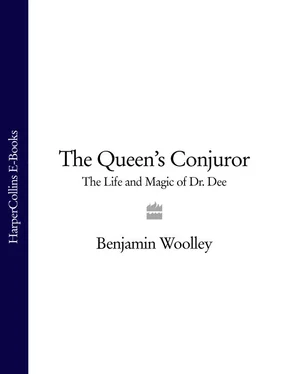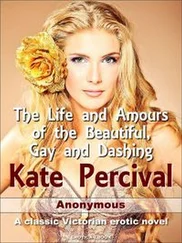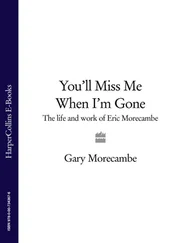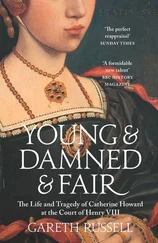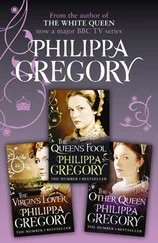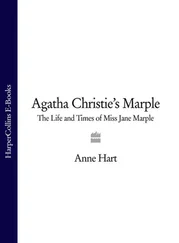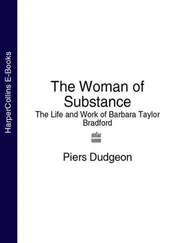The answer, he was about to discover, was ‘Yes’.
In 1547, the year of his dramatic debut at Trinity, Dee noted that at 10pm on 10 August he and a ‘Master Christopherson’ heard the nocturnal song of ‘whistlers’. This is the earliest surviving entry in Dee’s private diary. It is no ordinary journal. Diaries and calendars of the modern sort were not yet invented. The nearest equivalent, printed ephemerides, contained astrological tables plotting the positions of the planets for each month of the year. Dee used these to record notable events, each entry being scrawled next to the row tabulating the heavens’ disposition for the relevant period or day. It is likely he was thus trying to identify links between his personal life and celestial events. The result is a uniquely intimate diary of Elizabethan life. Unfortunately, his often illegible notes are frustratingly terse and have been patchily preserved. For the years 1547 to 1554, just six entries remain, only surviving today because the antiquarian Elias Ashmole happened to copy them down over a century later.
The entry concerning the whistlers is a typical one. The presence of Master Christopherson is unexplained. Even his identity is a mystery, though he may have been John Christopherson, later Catholic Bishop of Chichester between 1557 and 1558, who in Queen Mary’s reign Dee would encounter during interrogations of Protestant heretics. Dee does not even mention where this incident took place. The significance of the birdsong is also unclear. Edmund Spenser later noted in The Faerie Queen that the ‘Whistler shrill’ was a bad omen, ‘that who so hears, doth die’. 1
Dee later recalled that his interest in astronomy first flourished during this period. Each clear night he would stand beneath the firmament, set up his quadrant or cross-staff, and make ‘observations (very many to the hour and minute) of the heavenly influences and operations actual in this elemental portion of the world. Of which sort I made some thousands in the years then following.’ 2
A cross-staff, its use was as awkward and uncomfortable as this contemporary illustration suggests. To find the angle between two points (such as the horizon and a star), the observer would need to align the top and bottom of each cross bar with both points. The angle between them could then be measured off a scale marked along the main shaft. (Museum of the History of Science, Oxford.)
Dee soon discovered, however, that England did not provide the best intellectual viewpoint for surveying the secrets of the universe. To find out all the latest advances, both scientific and astronomical, he needed to travel abroad, in particular to the Low Countries, the place where the light of the Renaissance now shone with its fullest intensity.
The Low Countries have since split into Belgium, the Netherlands and Luxembourg. They were termed ‘low’ because so much of the land was beneath the level of the North Sea. Rich and successful commercial centres, they were also prone to floods of foreign influences, what Dee called the ‘intertraffique of the mind’. Radical Protestantism poured in from Germany, Renaissance science and art from Italy, news of navigational discoveries from Portugal, and imperial forces from Spain, whose king, Charles V, now ruled the entire region. 3
On 24 June 1548, Dee arrived at Louvain, near Brussels. It was home to the finest university in the region, which had been adopted by English reformers such as Dee’s friend and fellow academic Roger Ascham as a model for educational innovation. 4 The town’s strong Protestant sympathies, braced against the Catholicism of the Imperial authorities, gave the university’s schools an intense, unsettled, but exciting atmosphere which was made all the more precarious by, as Dee noted in his diary, the recent arrival from Spain of Philip, Charles V’s son and heir.
Dee enrolled on a law course ‘for leisure’, but spent much of his time among the mathematicians, in particular a group clustered around the eminent scientist and physician Gemma Frisius. 5 Frisius (1508-1555) was the university’s professor of medicine and mathematics, and practised as a physician in the town. However, his most important work was geographical not medical. Frisius pioneered the use of triangulation in land surveying, which enabled the position of a remote landmark to be measured from two points a known distance apart. The method relied on trigonometry, then almost unknown in England. 6
Under Frisius’s influence, Louvain had become caught up in a rapture of scientific measurement, a mood reflected in the contemporary Flemish picture The Measurers. 7 Frisius set up one of the finest workshops in Europe making measuring instruments. It was run by the engraver and goldsmith Gaspar à Mirica, and some of the leading cartographers of the Renaissance were apprenticed there.
In amongst the cross-staffs and astrolabes in Mirica’s workshop, Dee encountered Frisius’s leading cartographer, Gerard Mercator. 8 He was labouring away on a series of globes and maps that incorporated the discoveries made by Columbus and his successors in the New World. Dee became fascinated by Mercator’s painstaking work, watching over his shoulder as a picture of the world emerged that to sixteenth-century eyes would have been just as startling and significant as the first photographs of Earth taken from space were in the twentieth. Medieval charts typically depicted the world as a disk or semicircle comprising three continents divided by the Mediterranean, Asia at the top, Europe to the left, Africa to the right and Jerusalem in the centre. 9 They also often showed religious features, such as the Garden of Eden and the Tower of Babel. 10 Mercator’s maps, in contrast, were starkly geographical, showing a world made up of four continents, its curved surface ‘projected’ onto a rectangular map using a mathematical method that enabled accurate navigation.
It was in the midst of these Measurers of Louvain that Dee’s ‘whole system of philosophising in the foreign manner laid down its first and deepest roots’. 11 He and the thirty-six-year-old Mercator became inseparable. ‘It was the custom of our mutual friendship and intimacy that, during three whole years, neither of us willingly lacked the other’s presence for as much as three whole days,’ he reminisced years later. As a mark of his respect and affection, Mercator gave Dee a pair of his globes, one of the earth, the other of the heavens, objects of huge financial and scientific value. In return Dee later dedicated his astronomical work, Propaedeumata Aphoristica (1558), to Mercator.
At Louvain, Dee also practised his skill using such instruments as the cross-staff, perhaps during surveying expeditions guided by Frisius and Mercator, stealing off into the dangerous hinterland of cosmological speculation. Only a few years before Dee’s arrival, news of Copernicus’ heretical theory about the sun rather than the earth being at the centre of the universe had started to seep out of Germany. It was first described in an account by George Rheticius (which Dee owned, though it is unclear when he bought it), 12 and later published in full in 1543 in Copernicus’ own De Revolutionibus. Whether or not Dee and Mercator were discussing Copernicus’ ideas at this point is uncertain but they were experimenting with new models of the universe. Mercator even made one from brass, especially for Dee. Dee called it a ‘theorick’. At first glance the theorick might have appeared to reflect the orthodox view of the universe, comprising a series of concentric rings made of brass representing the spheres thought to carry the planets and stars. But Dee mentions it having rings for the ninth and tenth spheres. 13 According to the standard view of the universe, there were eight spheres: seven carrying the planets (the Moon, Mercury, Venus, the Sun, Mars, Jupiter, Saturn), and an outer shell carrying the stars. Ptolemy also proposed a ninth sphere, the primum mobile or divine force that drove the cosmic system. Mercator’s ‘theorick’ had ten rings, which at least suggests that it was unconventional, though in what way is impossible to know, as the device, like Mercator’s globes, was later stolen from Dee’s house.
Читать дальше
